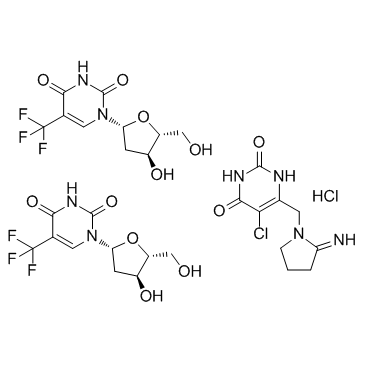| Cas No.: | 733030-01-8 |
| Chemical Name: | Trifluridine-tipiracil hydrochloride mixture |
| Synonyms: | Trifluridine-tipiracil hydrochloride mixture |
| SMILES: | O=C1N([C@H]2C[C@H](O)[C@@H](CO)O2)C=C(C(F)(F)F)C(N1)=O.O=C3NC(CN4CCCC4=N)=C(Cl)C(C3)=N.N.Cl |
| Formula: | C10H11F3N2O5.1/2C9H11ClN4O2.1/2HCl |
| M.Wt: | 435.76 |
| Sotrage: | 2 years -20°C Powder, 2 weeks 4°C in DMSO, 6 months -80°C in DMSO |
| Description: | Trifluridine-tipiracil hydrochloride mixture (TAS-102) is a novel oral combination drug that consists of an antineoplastic thymidine-based nucleoside analog, trifluorothymidine, and a potent thymidine phosphorylase inhibitor, tipiracil, in a 1:0.5 molar ratio. |
| In Vivo: | Trifluridine-tipiracil hydrochloride mixture (TAS-102) and CPT-11 is a promising treatment option for colorectal or gastric cancer. Trifluridine-tipiracil hydrochloride mixture monotherapy has a significant antitumor activity against KM12C/5-FUFU-bearing nude mice. The combination-treated (CPT-11-and Trifluridine-tipiracil hydrochloride mixture) group is significantly superior to monotherapy[2]. FTD systemic exposure in plasma increaseS dose-dependently. The tumor growth rate and body weight gain decreaseS dose-dependently, but FTD concentrations in the DNA of tumor tissues and white blood cells increases dose-dependently. FTD inhibits colony formation of bone marrow cells in a concentration-dependent manner[3]. |
| In Vitro: | Trifluridine-tipiracil hydrochloride mixture (TAS-102), a novel antimetabolite combination chemotherapy agent, consists of a rediscovered antimetabolite agent, trifluorothymidine (trifluridine, FTD) combined with the metabolic inhibitor of thymidine phosphorylase, tipiracil (TPI), in a 1:0.5 molar ratio[1]. FTD is the active antitumor component of Trifluridine-tipiracil hydrochloride mixture (TAS-102); its monophosphate form inhibits thymidylate synthase, and its triphosphate form is incorporated into DNA in tumor cells. The incorporation into DNA is known to have antitumor effects, since the inhibition of thymidylate synthase caused by oral FTD rapidly disappears after the drug's elimination. When FTD is administered orally, it is rapidly degraded to its inactive form by thymidine phosphorylase in the intestines and liver (first-pass effect). Consequently, TPI is synthesized to maintain adequate plasma concentrations of orally-administered FTD and to potentiate the antitumor activity of FTD[2]. |

 DC Chemicals' products qualify for U.S. tariff exemptions. We guarantee no price increases due to customs duties and maintain stable supply, continuing to deliver reliable research solutions to our American clients.
DC Chemicals' products qualify for U.S. tariff exemptions. We guarantee no price increases due to customs duties and maintain stable supply, continuing to deliver reliable research solutions to our American clients.





















